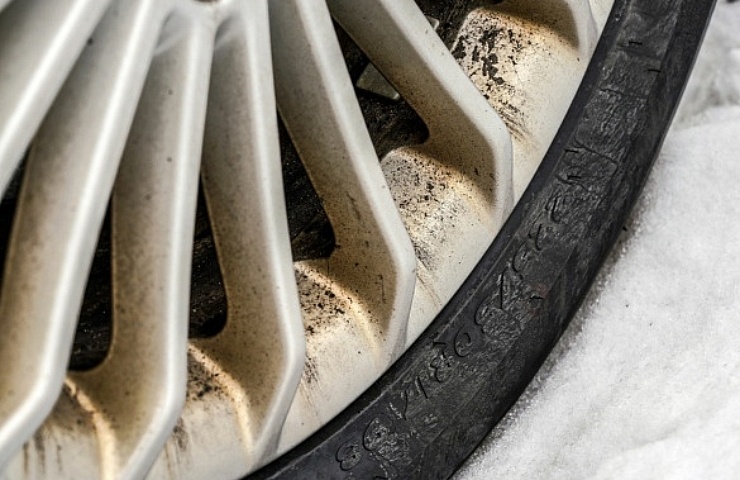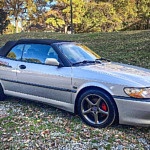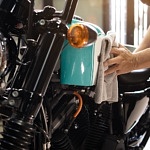Contents
Brake pads are designed to be ground down as they clamp on the brake disc, producing fine dust. This brake dust is created every time the pedal is depressed, and it’s an issue with zero-emission electric cars as much as it is in vehicles with a tailpipe.
What Is Brake Dust?
Brake dust is made up of iron particles caused by the brake pads’ grinding of the cast-iron brake rotor. In addition, brake dust contains some metallic elements and carbon residue from the brake pad.
The dust produces more fine particulate matter pollution (20 percent of the total from cars) than exhaust fumes (just seven percent). In addition, airborne dust unites with sulfate-rich particles in the air to create a toxic aerosol.
Fortunately, American-made brake pads no longer contain asbestos. But they did from the 1920s on—that’s how a company like Raybestos got its name. Asbestos, if undisturbed, is relatively stable and inert, but once it’s airborne, it’s hazardous and can lodge in the lungs and cause cancer.
Most automakers stopped using asbestos in brake pads during the 1990s (though it was not banned altogether). For instance, in California and Washington, the law says that heavy metals, including asbestos, chromium, cadmium, lead, or mercury, can be no more than 0.1 percent by weight in the pad. And some inexpensive imported pads contain asbestos.
Brake Dust from Different Types of Brake Pads
Today’s pads contain aramid, petroleum coke, and other compounds, all of which will turn to dust during the wearing process. Ceramic brake pads are a composite that contains about five percent ceramic. While most produce less dust, some ceramic pads have just as much dust as non-ceramic pads.

Akebono ceramic brake pads
Semi-metallic brake pads are the most common. A bundle of steel fibers is compressed and fused with other additives to build a pad. Steel fiber can make up 30 percent of the brake pad.
Kevlar brake pads are expensive and rarely used as standard equipment, though they perform well and typically outlast standard brake pads. In addition, there is a significant reduction in brake dust and rotor abrasion.
Shop now for ceramic brake padsTwo sets of pads from the same vendor can sometimes produce different amounts of dust, even if the brake pads are the same part number.
Why Your Car Hates Brake Dust
Brake dust is not only unsightly and hazardous to health, it also causes problems for your car, specifically an annoying squealing sound when the brakes are applied. This squealing or vibration happens when brake dust gets between the back of the brake pad and the caliper piston.
Anti-squeal pads are helpful. They’re available on the aftermarket and can be retrofitted. Adhesive or brake pad grease (sold in packets) can also be applied to the back of the brake pad.
Related: Why Should You Grease Brake Pads and How to Do It
Drum brakes are more likely than disc brakes to squeal because of brake dust. When disc brakes squeal, it’s a matter of resonant frequency between the pad and the rotor being transmitted into the caliper and caliper bracket. Most pads come with shims to mitigate this.
How to Clean Your Brakes
Squealing drum brakes can be quieted by washing the dust off the brake shoes and out of the drum with soapy water. Let them dry before reinstalling.

Wheel detailing brushes make quick work of brake dust removal.
When you remove a brake drum loaded with brake dust, never blow the dust off with air. Don’t sweep or brush it off or put your face close to the dusty brake assembly. Liberally wet the dusty brakes with soapy water because wet dust is less likely to enter your lungs. Mesothelioma can ruin your life. It’s like smoking 10,000 packs of cigarettes in one minute.
Fortunately, cleaning brake dust is not that difficult; the main ingredients are wheel cleaner and elbow grease.
Shop now for wheel detailing brusheseBay offers two types of wheel cleaners: acid and non-acid types. What’s the difference?
Autoglym reports:
Both are great at removing brake dust, dirt, and grime from wheels…But acid wheel cleaners are generally only necessary on heavily tarnished wheels where dirt and dust have been left to dry and create a heavy build-up on the surface. If wheels are washed regularly, as they should be, a non-acid based wheel cleaner will remove most light dust and dirt to reveal the clean surface below.
Acid types include hydrofluoric acid, which works well for cleaning both alloy and chromed wheels. But hydrofluoric acid is dangerous in cases of high-concentration inhalation. That doesn’t mean you shouldn’t use acid cleaners, but it’s worth reading the label to determine pH and acid concentration levels.

Chemical Guys Decon Pro Wheel Cleaner is up to the task.
To clean your wheels, here is what you will need:
- Bucket
- Sponge
- Wheel cleaner
- Hose and nozzle
- Soft bristle brush
- Liquid wax
Related: The Wonderful World of Car Detailing Brushes
How to Clean Brake Dust
- The wheels should be cool before you start.
- Rinse off the entire rim with water, removing grit and dirt that may scratch the wheel during the scrubbing.
- Cover the rim with wheel cleaner and allow it to soak for 60 seconds. Make sure you get the cleaner into all of the nooks and crannies of the wheel. This is where dust tends to accumulate.
- Use a soft bristle brush and scrub the surface of the wheel. Ensure the brush gets into all of the small, recessed areas of the wheel.
- Rinse off the wheel cleaner as soon as you have brushed the entire wheel. Do not leave the wheel cleaner on the wheel.
- Dry off the wheel immediately after rinsing.
Applying a coat of paste wax every few months will protect the wheels and make them easier to clean the next time brake dust builds up.
Shop now for wheel cleaner





